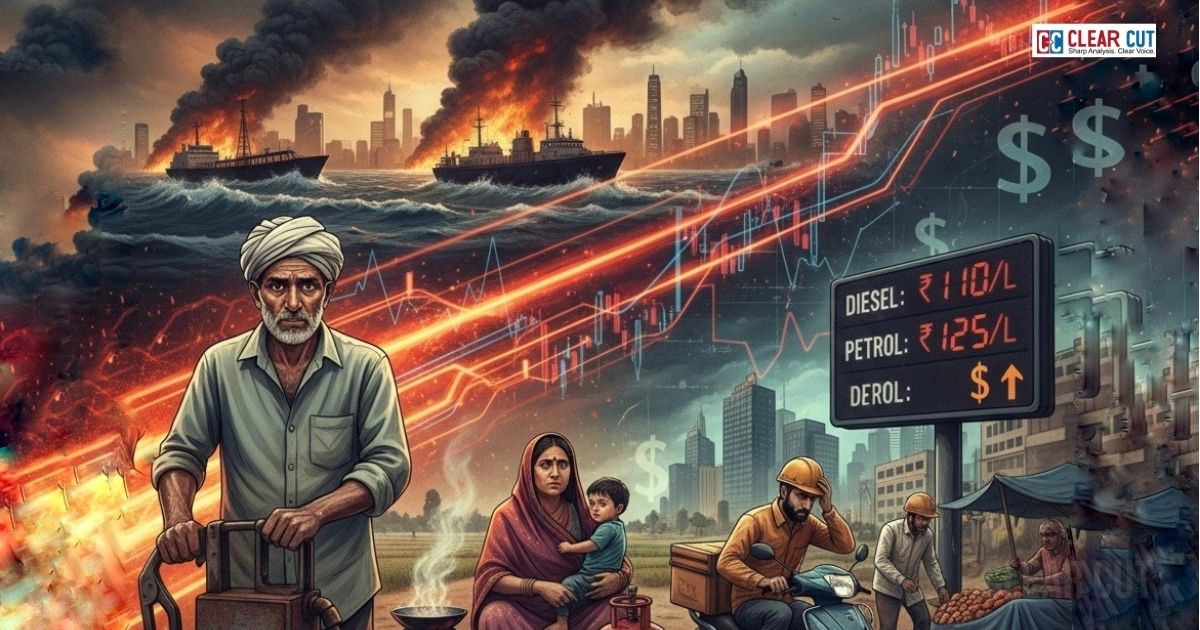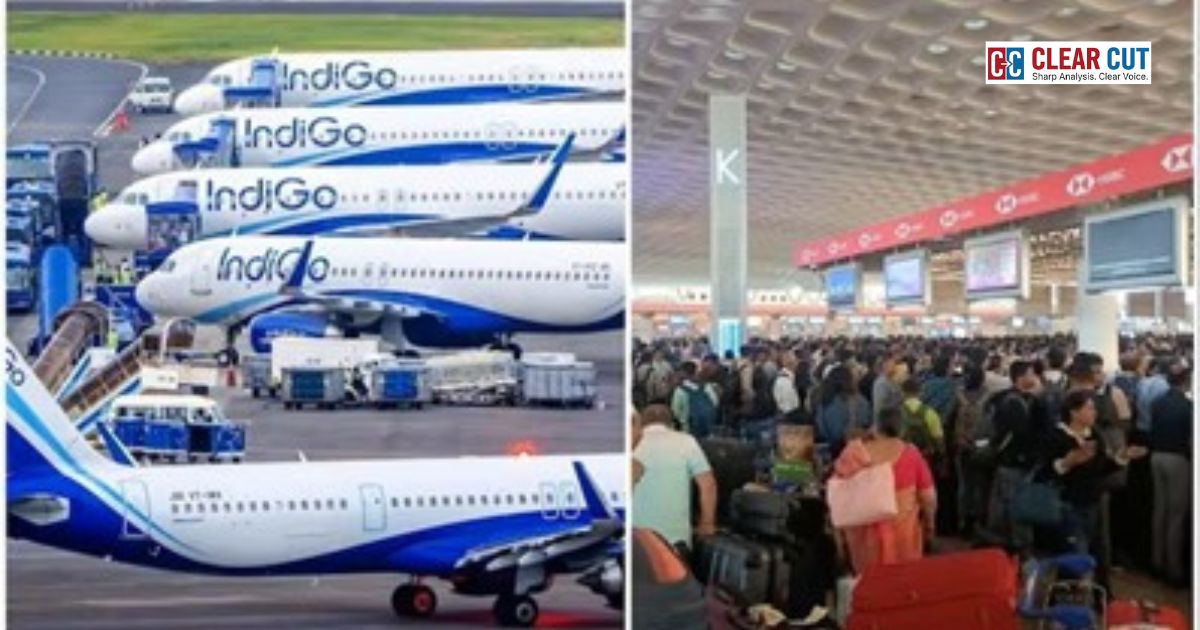Photo Credit: Antara Mrinal
Clear Cut Livelihood Desk
New Delhi, UPDATED: Oct 21, 2025 01:53 IST
Written By: Antara Mrinal
The Eastern Mediterranean has hardly caught its breath, before the rattling of the Israel-Gaza flare-up is felt across global foreign policy conduit and energy markets. For a country such as India, reliant on imported energy, the message is succinct: Middle East instability is no longer an untethered drama; it is a supply, diplomacy and strategic resilience stress test.
The Fragile Fault-Line: Ceasefire, Violation, Escalation
The current flashpoint follows a precarious truce, repeatedly punctuated by shelling, cross border raids, and a succession of ceasefire violations. Even as diplomatic backchannels work to stabilize, the region is highly fragile. Energy flows remain a choke point for the Middle East; the Suez Canal, the shipping lanes in the Eastern Mediterranean, the potential for regional escalation, can apply a “risk premium” to oil markets instantaneously.
Past incidents of flare-ups (e.g., exchanges between Israel and Iran that occurred in June 2025) saw Brent crude oil prices spike upwards of 7-11 percent, only to recede once escalatory risk dissipated. The messaging is that risk pricing occurs in near-real time and in real or practical terms in both directions.
Market Responses: Swings, Risks, Rebalancing
In recent days, oil indices have reacted in surprising ways to statements of political significance, indicating some sensitivity to the political climate. For example, when someone announced that India might be cutting back on buying Russian crude oil, Brent futures increased nearly 0.7 percent (RTT News). On the other hand, more sobering stories of oversupply in oil markets have reduced prices in recent months, with Brent averaging around $60-61 per barrel and U.S. West Texas Intermediate (WTI) prices closer to $57-58, evidence of a continuing, broader global supply overhang (Reuters).
Nonetheless, the fundamentals are now pushing back against this oversupply. The International Energy Agency has slightly increased its forecast of a global oversupply, now to 2.35 million bpd in 2025, increasing to 4 million bpd in 2026 (Reuters, now a two-year oversupply). Oil traders have been watching the build of inventories, the movement of production, and shadow oil flows (e.g., sanctioned oil from Russia and Iran) to understand where the floor really lies.
Another interesting indicator: crude oil sitting on meaningfully stationary tankers (often a proxy for uncertain flows) surged almost 8.9 percent week-on-week as of October 10. This suggests some traders are already hedging against disruption in trade flow, even facing demands that signal they seem to be sufficiently supply-constrained. In other words, markets are balancing the twin imperatives of geopolitical fear and arithmetic of supply. Volatility seems to have been firmly established since prices shifted significantly in July.
India’s Exposure: Imports, Budget, and Diplomacy
India obtains 80-90% of its oil imports and is especially vulnerable to external shocks (The Economic Times). In FY 2025, oil imports from Russia were 88 million tonnes out of 245 million tonnes (The Economic Times). The share of oil imports from Russia increased to roughly 40% in 2023-24 from a small amount in FY 2020 even as India amended its sourcing.
The new disclosure covering the period of April-September 2025 indicated that the Russian share had dropped to 36% (49 million tonnes) from 40% a year prior while imports from Middle Eastern sources increased from 42% to 45% (The Economic Times). During that same period of time imports of U.S. oil to India increased 6.8% YOY at that time when there was an average of 213,000 barrels per day imported (The Economic Times). Hence, there is some lowering of risk regarding energy, not a full re-investment into other sources.
In recent trade diplomacy, the U.S. had claimed that India was already lowering imports from Russia by 50%, with a report in Reuters specifying that Indian refiners we preparing for this decrease, but the months it would take to show up in their import records was the December or January time frame. The Indian government has countered by saying any change in trends needs to balance affordability, security of supply, and contractual realities.
Examining the matter through a budgetary lens, a mere $1 increase in crude oil prices can raise India’s import bill by tens of thousands of crores, which would mean higher prices for consumers or deeper subsidies. In uncertain periods, refiners may even face margin compression, logistic rerouting costs, and increased marine insurance premium resulting from a rise in perceived risk to transit lanes.
Fuel Costs and the Day to Day Economy
India imports roughly 87-90% of its crude oil so every time there is a minor increase in the price of crude oil at a global level, it will mean a proportionate pain domestically. For example, if Brent crude progresses upwards by $10 per barrel, India’s import bill will increase by $15-16 billion on an annual basis according to Reserve Bank of India (RBI) estimates. This in turn increases inflation across various sectors of the economy – the impact of crude oil on inflation does not begin and end with petrol and diesel prices; rather the impact is priced through transportation, food, fertilizers, and manufactured goods prices.
When the prices of fuel go up, the burden of inflation is borne disproportionately by the poor. Bus fares, vegetables, milk, and essential items rise in price. The National Statistics Office (NSO) has shown that poor households, both rural and urban, spend up to 50-60% of their income on food and fuel combined, meaning that even the slightest upward spike in inflation is enough to destabilize household budgets.
Take, for example, the year 2022-23, when oil prices spiked following Russia’s invasion of Ukraine and India’s Consumer Price Index (CPI) inflation struck a peak around 7.8%, resulting in the government cutting excise duties on petrol and diesel fuels to control price. Similar actions could ensue if tensions in the Middle East continue without resolution.
Implications for Subsidies, Welfare Spending, and Fiscal Policy
Rising oil prices put pressure on the government budget. The increase in import bills can either be passed along as increased prices to consumers, which brings with it social unrest, or absorbed through increased fuel or fertilizer support spending, which widens the fiscal deficits. The increase in fuel subsidies could cost the exchequer, in some cases, more than ₹15,000 crore per year based on consumption for every ₹1 of subsidy assistance increased, which is substitution money that could have been spent on rural employment programs (MGNREGA), health missions, or educational programs.
Thus, geopolitical shocks in the oil mark oftentimes dictate the welfare spend budget and trade-offs in welfare budgets, especially for cash-strapped marginalized regions or areas already in fiscal distress. Historically, fuel shocks set in motion delays in spending and under funded programs such as the PM-KISAN, rural housing programs (PMAY-G), and nutrition programs targeted for the poorest state economies like Bihar, Jharkhand, Odisha and Madhya Pradesh.
Rural Livelihoods and Agricultural Inputs
The economy of rural India is diesel dependent – from irrigation pumps to tractors, to the transport of produce. According to NABARD estimates, a ₹5/litre rise in diesel can raise the per-acre cost of farming by ₹300-400. This is disastrous for small and marginal farmers who account for 85% of the cultivators in India, particularly when crop prices do not rise in tandem.
At the same time, fertilizer prices are a second pressure point. Urea and DAP are derived from natural gas (another fossil input), and high global gas prices contribute to higher subsidy bills and often delayed supply at the village level. This causes reduced sowing, delayed sowing or higher rural indebtedness.
Energy-linked inflation also has an effect on prices of food, which affects producers and consumers in different ways – but the poorest lose in both instances: higher cost of production, and more expensive food items in the market.
Effects on the Urban Poor and Employment
For daily wage informal and low-income urban workers – drivers, street vendors, delivery workers, or construction workers – their income is also severely eroded as the fuel and transport costs rise.
When oil shocks occur, transportation and logistics profit margins increase, resulting in higher raw material costs for industries. Micro and small enterprises (MSMEs) that support over 110 million jobs are particularly sensitive when input costs fluctuate. In the past when oil prices increased transport and food delivery organizations passed through costs to workers (by cutting their incentives); this led to uncertainty and precarity in these sectors of the gig economy.
Simultaneously, sectors in aviation, tourism and manufacturing may experience reduced demand when energy prices rise, impacting job availability particularly for informal and contracted workers.
Energy Access and Inequality
Volatile energy prices slow India down in its advancement on energy access and clean cooking fuels. In the case of the Ujjwala Yojana, which provides means-tested LPG cylinder assistance for poor homes, refill rates declined in 2023-24 already when market prices went above ₹900 per cylinder. A renewed spike in prices may push millions of households back into biomass or firewood for cooking, which is highly polluting for indoor air quality, one of the leading causes of respiratory disease in women and children.
Various price fluctuations from coal and diesel can impact the cost-of-generation power sector. The final cost of power generation often has limited flexibility, leading to challenges with tariffs or supply restrictions ahead of demand. This is often exacerbated for poor households experiencing disconnections from supply, or outages that they cannot afford.
Remittance Risk and Gulf Employment
Currently, around 8.9 million Indians are employed in Gulf nations and send about $44 billion a year in remittances – literally lifelines for many families in Kerala, Bihar, and Uttar Pradesh. Any regional escalation that stops or changes the operational capability of Gulf economies, families could see reduced job security, delayed payments or increased migration back to home countries.
We saw tens of thousands of Indian workers repatriated to India during both the 1990-91 Gulf war and during 2011 (the Arab Spring). Instability in the Gulf could also see a return of the kind of social instability that negatively affected migrants. Essentially, instability can lead to disruption in livelihoods, particularly in the construction and service sector of these low-waged temporary workers.
What should Delhi and the Industry be doing right now?
For a first step, the priority for policymakers in India should be to establish a strategic oil reserve buffer and stress-tested procurement contracts against different disruption scenarios. Bilateral engagement with the Gulf and Asian partners over shipping security, intelligence-sharing, and emergency shipping corridors may become necessary.
For refiners and energy firms, the enterprise is running these stress tests on hedging mechanisms: Tata, Reliance, IOC, etc. will all need a mix of grades and rerouting flexibility and insurance hedges in contracts. Supply disruption scenario planning must be ingrained into boardroom activity.
Volatility as Default, Resilience as Imperative
The elevated tensions between Israel and Gaza do not serve only as a humanitarian and military story. They also serve as a painful reminder that energy supply chains are weak links in an interconnected world. Volatility could be the price of geopolitics, but for energy importers like India, the opportunity lies in fast adaptation: diversifying, hardening logistics, leveraging diplomacy, and moving toward clean alternatives. In a future in which every twist of foreign policy finds its way onto energy dashboards, adaptability is going to be India’s best hedge.




